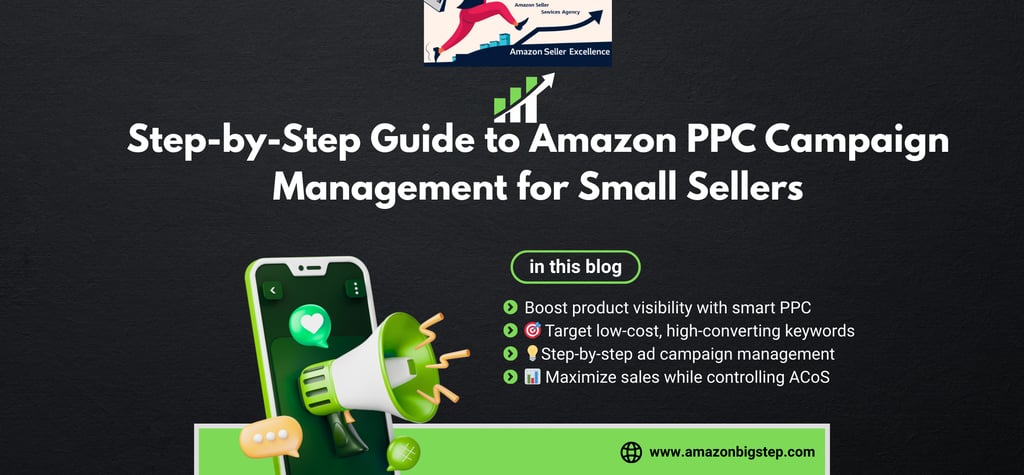Step-by-Step Guide to Amazon PPC Campaign Management for Small Sellers
Managing Amazon PPC (Pay-Per-Click) campaigns can feel overwhelming for small sellers, especially when budgets are tight and competition is tough. The good news is that with the right approach, even small sellers can run highly effective campaigns that maximize visibility, increase conversions, and scale profits. This guide will walk you step by step through Amazon PPC management services and Amazon ad campaign management, tailored specifically for small sellers who need results without overspending.
Amazon Big Step
9/24/20253 min read


1. Understanding Amazon PPC
Before diving into campaign creation, let’s clarify what Amazon PPC actually is:
Amazon PPC (Pay-Per-Click): An advertising model where you only pay when someone clicks your ad.
Goal: Improve product visibility, increase sales, and boost organic ranking.
The three main types of Amazon PPC ads are:
Sponsored Products – Appear within search results and product pages. Perfect for driving direct product sales.
Sponsored Brands – Banner-style ads at the top of search results. Great for brand awareness.
Sponsored Display – Display ads that retarget shoppers on and off Amazon.
For small sellers, Sponsored Products campaigns should be your starting point because they are cost-effective and bring the highest return.
2. Setting Clear PPC Goals
A successful campaign starts with defining your goals. Small sellers typically focus on:
Increasing product visibility
Driving more traffic to listings
Achieving profitable ACoS (Advertising Cost of Sales)
Improving organic ranking over time
👉 Example: A small seller may set a target ACoS of 25% while aiming to increase daily sales from 5 units to 10 units within three months.
3. Keyword Research for Amazon PPC
Keywords are the backbone of your campaigns. Without the right keywords, your ads won’t reach the right audience. Focus on:
Broad keywords: General terms (e.g., “wireless earbuds”).
Long-tail keywords: More specific, lower competition (e.g., “bluetooth earbuds with mic for workouts”).
Branded keywords: Competitors’ or your own brand name.
Tools for Amazon Keyword Research
Helium 10
Jungle Scout
Amazon Search Term Report (from your own campaigns)
👉 Pro Tip: For small sellers, prioritize long-tail keywords because they are less expensive and more targeted.
4. Structuring Your Amazon PPC Campaigns
An organized structure helps you manage ads more efficiently. A typical setup includes:
Automatic Campaigns: Amazon automatically matches your products with keywords. Use these for keyword discovery.
Manual Campaigns: You choose keywords, match types, and bids. Provides greater control.
Recommended Setup for Small Sellers
Start with one automatic campaign for keyword harvesting.
Create separate manual campaigns for:
Exact match (precisely targeted keywords)
Phrase match (slightly broader reach)
Broad match (wider audience, higher spend)
This structure allows you to test, refine, and control your ad spend.
5. Budgeting for Small Sellers
Budget management is critical. Overspending can kill profitability. Here’s how to allocate:
Start with $20–$50/day total budget (split across campaigns).
Focus on high-converting keywords first.
Gradually scale up budgets for campaigns with proven ROI.
👉 Rule of Thumb: Never scale based on impressions alone. Scale based on conversions and ACoS.
6. Bid Management
Your bid determines where your ad shows up. For small sellers:
Low Competition Keywords: Start with lower bids ($0.30–$0.60).
High Competition Keywords: Start moderately ($0.80–$1.20) and adjust.
Use dynamic bidding (down only) in the beginning to prevent overspending.
7. Crafting Effective Ad Copy & Creative
Your ads are only as good as your listing. Make sure your product page is optimized:
Title: Keyword-rich but natural.
Bullet Points: Highlight features and benefits.
Images: High-quality, lifestyle images.
A+ Content: Builds trust and improves conversion rate.
👉 Without strong listing optimization, your PPC budget will go to waste.
8. Campaign Optimization Process
Optimization is the heart of Amazon ad campaign management. Here’s the step-by-step process:
Monitor Search Term Reports – Find out which search terms drive sales.
Add Negative Keywords – Block irrelevant terms to save money.
Adjust Bids Regularly – Increase bids for converting keywords, decrease for poor performers.
Pause Ineffective Ads – Don’t waste money on ads with no conversions.
👉 Best Practice: Review campaigns every 7–14 days for adjustments.
9. Tracking & Metrics
To measure success, monitor these KPIs:
ACoS (Advertising Cost of Sales) – Percentage of ad spend vs. sales. Target depends on profit margin.
TACoS (Total Advertising Cost of Sales) – Includes both ad sales and organic sales impact.
CTR (Click-Through Rate) – Indicates ad relevance.
CVR (Conversion Rate) – Measures how well your listing converts clicks into purchases.
👉 Example: If your ACoS is higher than your profit margin, you need to optimize or pause that campaign.
10. Scaling Your Campaigns
Once you find profitable campaigns:
Increase budgets gradually (10–20% weekly).
Expand into Sponsored Brands or Sponsored Display ads.
Test new keyword sets and product targeting ads.
For small sellers, scaling slowly ensures you don’t burn through cash while still growing visibility.
11. When to Use Amazon PPC Management Services
Small sellers often reach a point where managing campaigns alone becomes too time-consuming. This is when Amazon PPC management services can help:
Professional keyword research & bid optimization
ACoS reduction strategies
Advanced campaign structuring
Data-driven reporting and scaling
Hiring an Amazon PPC agency allows sellers to focus on their business while experts handle ad efficiency.
Final Thoughts
Amazon PPC doesn’t have to drain your budget. With careful planning, proper keyword research, and consistent optimization, small sellers can run highly profitable ad campaigns. Start small, stay data-driven, and refine along the way. Whether you do it yourself or partner with a team offering Amazon ad campaign management services, the key is consistency and smart decision-making.
Key Takeaways for Small Sellers
Start with Sponsored Products campaigns.
Use both automatic (discovery) and manual (control) campaigns.
Prioritize long-tail, low-competition keywords.
Optimize listings before investing in ads.
Monitor ACoS, TACoS, CTR, and CVR regularly.
Scale only after finding proven winners.
By following this step-by-step approach, small sellers can leverage Amazon PPC to compete with bigger brands and steadily grow their sales.
Expertise
Your partner for Amazon growth and success.
Services
Insights
connect@amazonbigstep.com
+1 (859)4182348
© 2025. All rights reserved.
